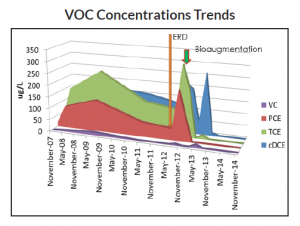
On February 18, REGENESIS hosted a webinar titled “In Situ Remediation Strategies for Chlorinated Solvents in Groundwater”. Special guest Steven Sittler, Senior Project Manager at KERAMIDA Inc., presented case studies and discussed how enhanced reductive dechlorination and bioaugmentation were used on-site.
During the presentation, Mr. Sittler stressed the importance of the “3 D’s” – Donor, DHC and Distribution. On many of the sites he has worked on, Mr. Sittler used 3-D Microemulsion for the donor product and BDI Plus as the dehalococcoides sp. However, he emphasized that distribution is equally as important as the products. “It doesn’t matter how good the products are if you can’t get them where they need to be. So it’s very important to have a good partner…and to have a good understanding of what is happening on-site,” he says.
A selection of the case studies presented by Mr. Sittler have now been published in full on our website. To access each case study, please click this links below.
Featured Case Studies
Combined Remedies Treatment Results in a $650,000 Cost Savings for End User


 Americas
Americas Europe
Europe Français
Français Deutsch
Deutsch Italiano
Italiano Español
Español


